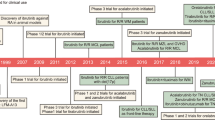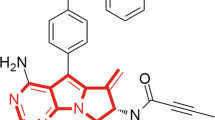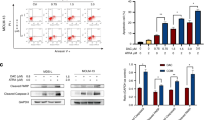Abstract
Rheumatoid arthritis (RA) is characterized by persistent joint synovial tissue inflammation. Leflunomide is an immunomodulatory agent that has been approved for treatment of active RA. In the past few years, uses other than RA treatment have appeared. Leflunomide has been reported to show antitumor potential through inhibition of cancer cell proliferation. We thus tested the antiproliferative potential of leflunomide on HEL and K562 erythroleukemia cells. The findings summarized in this report demonstrate for the first time that low dose leflunomide prolonged survival and reduced apoptosis induced by several anticancer agents in erythroleukemia cells. We showed that in treated cells, leflunomide reduced the signalling pathways involved in promoting apoptosis by reducing p38 MAPK and JNK basal activity. On the other hand, leflunomide transiently activated the ERK signalling pathway and induced a sustained activation of Akt. We also showed that leflunomide reduced caspase-3 activity and DNA fragmentation induced by anticancer agents. By using an inhibitory strategy, we showed that inhibition of Akt activation but not ERK abolished the protective effect of leflunomide. Thus our findings suggested that leflunomide reduced apoptosis induced by anticancer agents through PI3K/Akt signalling activation.
Similar content being viewed by others
References
Lee DM, Weinblatt ME (2001) Rheumatoid arthritis. Lancet 358:903–911
Firestein GS (2003) Evolving concepts of rheumatoid arthritis. Nature 423:356–361
Thomas E, Brewster DH, Black RJ, Macfarlane GJ (2000) Risk of malignancy among patients with rheumatic conditions. Int J Cancer 88:497–502
Senel S, Kaya E, Aydogdu I, Erkurt MA, Kuku I (2006) Rheumatic diseases and chronic myelogenous leukemia, presentation of four cases and review of the literature. Rheumatol Int (in press)
Smolen JS, Kalden JR, Scott DL, et al (1999) Efficacy and safety of leflunomide compared with placebo and sulphasalazine in active rheumatoid arthritis: a double-blind, randomised, multicentre trial. European Leflunomide Study Group. Lancet 1353:259–266
Smolen JS, Emery P, Kalden JR, et al (2004) The efficacy of leflunomide monotherapy in rheumatoid arthritis: towards the goals of disease modifying antirheumatic drug therapy. J Rheumatol 71:13–20
Greene S, Watanabe K, Braatz-Trulson J, Lou L (1995) Inhibition of dihydroorotate dehydrogenase by the immunosuppressive agent leflunomide. Biochem Pharmacol 50:861–867.
Davis JP, Cain GA, Pitts WJ, Magolda RL, Copeland RA (1996) The immunosuppressive metabolite of leflunomide is a potent inhibitor of human dihydroorotate dehydrogenase. Biochem 35:1270–1273
Arora A, Scholar EM (2005) Role of tyrosine kinase inhibitors in cancer therapy. J Pharmacol Exp Ther 315:971–979
Ghosh S, Zheng Y, Jun X, et al (1998) Alpha-cyano-beta-hydroxy-beta-methyl-N-[4-(trifluoromethoxy)phenyl] propenamide: an inhibitor of the epidermal growth factor receptor tyrosine kinase with potent cytotoxic activity against breast cancer cells. Clin Cancer Res 4:2657–2668
Xu X, Shen J, Mall JW, et al (1999) In vitro and in vivo antitumor activity of a novel immunomodulatory drug, leflunomide: mechanisms of action. Biochem Pharmacol 58:1405–1413
Liagre B, Vergne-Salle P, Corbiere C, Charissoux JL, Beneytout JL (2004) Diosgenin, a plant steroid, induces apoptosis in human rheumatoid arthritis synoviocytes with cyclooxygenase-2 overexpression. Arthritis Res Ther 6:R373–383
Liagre B, Bertrand J, Leger DY, Beneytout JL (2005) Diosgenin, a plant steroid, induces apoptosis in COX-2 deficient K562 cells with activation of the p38 MAP kinase signalling and inhibition of NF-kappaB binding. Int J Mol Med 16:1095–1101
Leger DY, Liagre B, Beneytout JL (2006) Role of MAPKs and NF-kappaB in diosgenin-induced megakaryocytic differentiation and subsequent apoptosis in HEL cells. Int J Oncol 28:201–207
Leger DY, Liagre B, Corbiere C, Cook-Moreau J, Beneytout JL (2004) Diosgenin induces cell cycle arrest and apoptosis in HEL cells with increase in intracellular calcium level, activation of cPLA2 and COX-2 overexpression. Int J Oncol 25:555–562
Spodnik JH, Wozniak M, Budzko D, et al (2002) Mechanism of leflunomide-induced proliferation of mitochondria in mammalian cells. Mitochondrion 2:163–179
Cao WW, Kao PN, Chao AC, Gardner P, Ng J, Morris RE (1995) Mechanism of the antiproliferative action of leflunomide. A77 1726, the active metabolite of leflunomide, does not block T-cell receptor-mediated signal transduction but its antiproliferative effects are antagonized by pyrimidine nucleosides. J Heart Lung Transplant 14:1016–1030
Johnson GL, Lapadat R (2002) Mitogen-activated protein kinase pathways mediated by ERK, JNK, and p38 protein kinases. Sci 298:1911–1912
Xia Z, Dickens M, Raingeaud J, Davis RJ, Greenberg ME (1995) Opposing effects of ERK and JNK-p38 MAP kinases on apoptosis. Sci 270:1326–1331
Thompson JE, Thompson CB (2004) Putting the rap on Akt. J Clin Oncol 22:4217–4226
Brognard J, Clark AS, Ni Y, Dennis PA (2001) Akt/protein kinase B is constitutively active in non-small cell lung cancer cells and promotes cellular survival and resistance to chemotherapy and radiation. Cancer Res 61:3986–3997
Mosmann T (1983) Rapid colorimetric assay for cellular growth and survival: application to proliferation and cytotoxicity assays. J Immunol Methods 65:55–63
van Roon EN, Yska JP, Raemaekers J, Jansen TL, van Wanrooy M, Brouwers JR (2004) A rapid and simple determination of A77 1726 in human serum by high-performance liquid chromatography and its application for optimization of leflunomide therapy. J Pharm Biomed Anal 36:17–22
Towatari M, Iida H, Tanimoto M, Iwata H, Hamaguchi M, Saito H (1997) Constitutive activation of mitogen-activated protein kinase pathway in acute leukemia cells. Leukemia 11:479–484
Milella M, Kornblau SM, Estrov Z, et al (2001) Therapeutic targeting of the MEK/MAPK signal transduction module in acute myeloid leukemia. J Clin Invest 108:851–859
Platanias LC (2003) Map kinase signaling pathways and hematologic malignancies. Blood 101:4667–4679
Tamemoto H, Kadowaki T, Tobe K, et al (1992) Biphasic activation of two mitogen-activated protein kinases during the cell cycle in mammalian cells. J Biol Chem 267:20293–20297
Favata MF, Horiuchi KY, Manos EJ, et al (1998) Identification of a novel inhibitor of mitogen-activated protein kinase kinase. J Biol Chem 273:18623–18632
Zhang Y, Huang Y, Rishi AK, et al (1999) Activation of the p38 and JNK/SAPK mitogen-activated protein kinase pathways during apoptosis is mediated by a novel retinoid. Exp Cell Res 247:233–240
Iwama K, Nakajo S, Aiuchi T, Nakaya K (2001) Apoptosis induced by arsenic trioxide in leukemia U937 cells is dependent on activation of p38, inactivation of ERK and the Ca2+-dependent production of superoxide. Int J Cancer 92:518–526
Kutuk O, Pedrech A, Harrison P, Basaga H (2005) Pramanicin induces apoptosis in Jurkat leukemia cells: a role for JNK, p38 and caspase activation. Apoptosis 10:597–609
Brantley-Finley C, Lyle CS, Du L, et al (2003) The JNK, ERK and p53 pathways play distinct roles in apoptosis mediated by the antitumor agents vinblastine, doxorubicin, and etoposide. Biochem Pharmacol 66:459–469
Wang D, Li H, Yuan H, et al (2005) Humanin delays apoptosis in K562 cells by downregulation of P38 MAP kinase. Apoptosis 10:963–971
Huang M, Wang Y, Collins M, Mitchell BS, Graves LM (2002) A77 1726 induces differentiation of human myeloid leukemia K562 cells by depletion of intracellular CTP pools. Mol Pharmacol 62:463–472
Nagata Y, Takahashi N, Davis RJ, Todokoro K (1998) Activation of p38 MAP kinase and JNK but not ERK is required for erythropoietin-induced erythroid differentiation. Blood 92:1859–1869
Witt O, Sand K, Pekrun A (2000) Butyrate-induced erythroid differentiation of human K562 leukemia cells involves inhibition of ERK and activation of p38 MAP kinase pathways. Blood 95:2391–2396
Lee HH, Dadgostar H, Cheng Q, Shu J, Cheng G (1999) NF-kappaB-mediated up-regulation of Bcl-x and Bfl-1/A1 is required for CD40 survival signaling in B lymphocytes. Proc Natl Acad Sci USA 96:9136–9141
Manna SK, Mukhopadhyay A, Aggarwal BB (2000) Leflunomide suppresses TNF-induced cellular responses: effects on NF-kappa B, activator protein-1, c-Jun N-terminal protein kinase, and apoptosis. J Immunol 165:5962–5969
Vergne-Salle P, Leger DY, Bertin P, Treves R, Beneytout JL, Liagre B (2005) Effects of the active metabolite of leflunomide, A77 1726, on cytokine release and the MAPK signalling pathway in human rheumatoid arthritis synoviocytes. Cytokine 31:335–348
Hammerman PS, Fox CJ, Birnbaum MJ, Thompson CB (2005) Pim and Akt oncogenes are independent regulators of hematopoietic cell growth and survival. Blood 105:4477–4483
Osaki M, Oshimura M, Ito H (2004) PI3K-Akt pathway: its functions and alterations in human cancer. Apoptosis 9:667–676.
Datta SR, Brunet A, Greenberg ME (1999) Cellular survival: a play in three Akts. Genes Dev 13:2905–2927
Knuefermann C, Lu Y, Liu B, et al (2003) HER2/PI-3K/Akt activation leads to a multidrug resistance in human breast adenocarcinoma cells. Oncogene 22:3205–3212
Kolitz JE, George SL, Dodge RK, et al (2004) Dose escalation studies of cytarabine, daunorubicin, and etoposide with and without multidrug resistance modulation with PSC-833 in untreated adults with acute myeloid leukemia younger than 60 years: final induction results of Cancer and Leukemia Group B Study 9621. J Clin Oncol 22:4290–4301
Russo D, Malagola M, de Vivo A, et al (2005) Multicentre phase III trial on fludarabine, cytarabine (Ara-C), and idarubicin versus idarubicin, Ara-C and etoposide for induction treatment of younger, newly diagnosed acute myeloid leukaemia patients. Br J Haematol 131:172–179
Yu C, Dai Y, Dent P, Grant S (2002) Coadministration of UCN-01 with MEK1/2 inhibitors potently induces apoptosis in BCR/ABL+ leukemia cells sensitive and resistant to ST1571. Cancer Biol Ther 1:674–682
Hahn M, Li W, Yu C, Rahmani M, Dent P, Grant S (2005) Rapamycin and UCN-01 synergistically induce apoptosis in human leukemia cells through a process that is regulated by the Raf-1/MEK/ERK, Akt, and JNK signal transduction pathways. Mol Cancer Ther 4:457–470
Mathews V, George B, Lakshmi KM, et al (2005) Single agent arsenic trioxide in the treatment of newly diagnosed acute promyelocytic leukemia: durable remissions with minimal toxicity. Blood (in press)
Latagliata R, Bongarzoni V, Carmosino I, et al (2006) Acute myelogenous leukemia in elderly patients not eligible for intensive chemotherapy: the dark side of the moon. Ann Oncol 17:281–285
Dai Y, Rahmani M, Pei XY, et al (2005) Farnesyltransferase inhibitors interact synergistically with the Chk1 inhibitor UCN-01 to induce apoptosis in human leukemia cells through interruption of both Akt and MEK/ERK pathways and activation of SEK1/JNK. Blood 105:1706–1716
Lee SM, Lee CT, Kim YW, Han SK, Shim YS, Yoo CG (2006) Hypoxia confers protection against apoptosis via PI3K/Akt and ERK pathways in lung cancer cells. Cancer Lett (in press)
Larribere L, Khaled M, Tartare-Deckert S, et al (2004) PI3K mediates protection against TRAIL-induced apoptosis in primary human melanocytes. Cell Death Differ 11:1084–1091
Tabellini G, Cappellini A, Tazzari PL, et al (2005) Phosphoinositide 3-kinase/Akt involvement in arsenic trioxide resistance of human leukemia cells. J Cell Physiol 202:623–634
Cardone MH, Roy N, Stennicke HR, et al (1998) Regulation of cell death protease caspase-9 by phosphorylation. Sci 282:1318–1321
Amaravadi R, Thompson CB (2005) The survival kinases Akt and Pim as potential pharmacological targets. J Clin Invest 115:2618–2624
Author information
Authors and Affiliations
Corresponding author
Rights and permissions
About this article
Cite this article
Leger, D.Y., Liagre, B. & Beneytout, J.L. Low dose leflunomide activates PI3K/Akt signalling in erythroleukemia cells and reduces apoptosis induced by anticancer agents. Apoptosis 11, 1747–1760 (2006). https://doi.org/10.1007/s10495-006-9439-7
Published:
Issue Date:
DOI: https://doi.org/10.1007/s10495-006-9439-7




